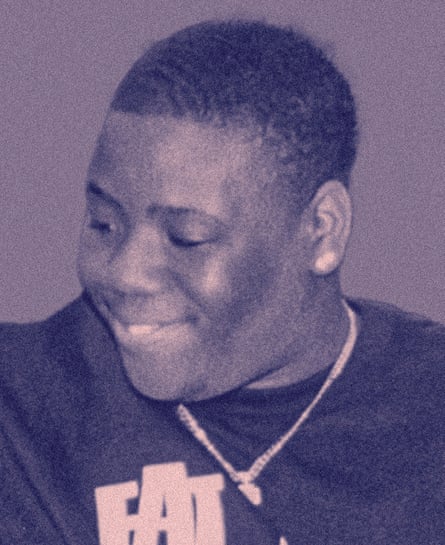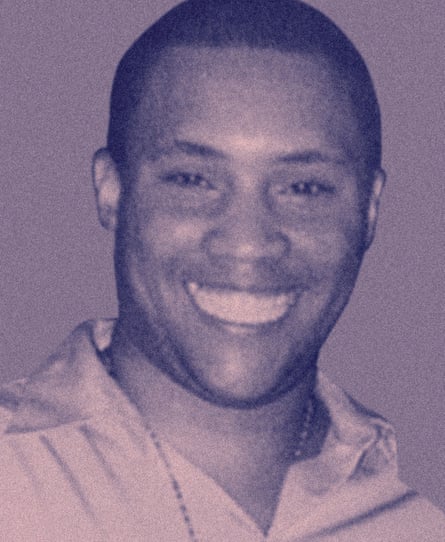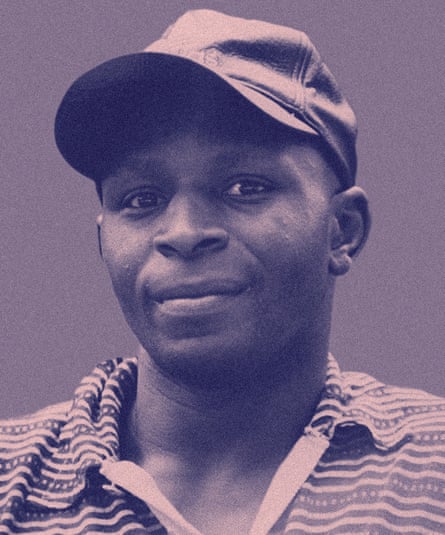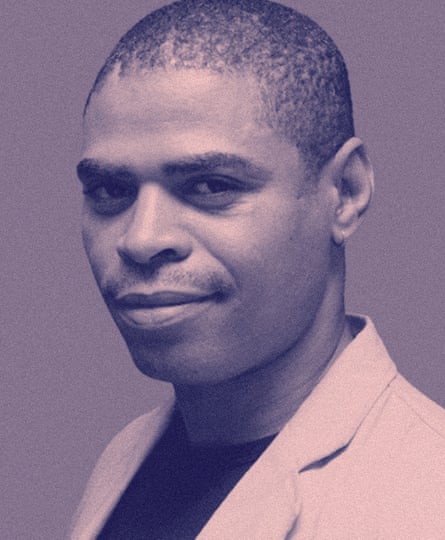‘How do I heal?’: the long wait for justice after a black man dies in police custody
In the early hours of Sunday 3 July 2022, two men, 300 miles apart, died after contact with police. One man was in Cornwall, and the other in Nottingham. Both men were unarmed, and had not harmed anyone. Both men were terrified; both had struggled with drug addiction; both were in the midst of a psychotic episode. Both were black. Both had called the police to help them.
Godrick Osei was 35 and a father of two. At around 2am, he placed two calls to his sister from his partner’s flat in Truro. He was in a paranoid state, and claimed men with guns were in the flat. Then he jumped out of the window, taking his partner’s phone. He rang the police himself, and said he was being chased by armed attackers.
Officers from Devon and Cornwall police found him at 2.30am: he had entered a care home and was hiding in a staff bathroom. His family, who have viewed the police bodycam footage, said that officers forced their way into the cubicle where he had hidden because he was so terrified, and a number of them restrained him. He died less than an hour later.

That same morning, in Nottingham, police arrived at the home of Kaine Fletcher to detain him under the mental health act. Fletcher, a 26-year-old father of two, was restrained by officers and later taken to hospital. Within a few hours, he was dead.
These deaths are part of a larger pattern: official data shows that black people die at twice the rate of white people in similar encounters with police. The role of racism in these cases is fiercely contested by the government and the police, but there is an explanation for the disproportionality. The common thread in almost all such cases is an exaggerated perception of the physical threat posed by the victims, even when they have called the police themselves, as Osei and Fletcher both had. Instead of being treated as the victims of a medical emergency, they were met with force – treated “like a criminal”, in the words of Kaine Fletcher’s father.
It is extremely rare for anyone to be held accountable for such deaths. In the past 35 years, only one police officer in England and Wales has been convicted of manslaughter following a death in police custody – and that was the case of the black former Premiership footballer Dalian Atkinson, who had been Tasered and kicked in the head.
England has a highly developed system for police accountability: every incident in which contact with officers may have caused death or serious injury must be referred to the Independent Office for Police Conduct (IOPC), which determines whether officers have a “case to answer” and should face a disciplinary meeting or hearing. But the IOPC has never concluded that a police officer has a case to answer for racial discrimination when a black person has died following police contact.
Beginning in 2021, I spent two years working for Inquest, the charity that provides information and support on state-related deaths, investigating the cases of black men in Britain who had died after contact with the police. What I found was alarming: the racial disproportionality in these deaths is even greater than the official figures reveal. Perhaps just as disturbing was the official denial that race played any part in them.

The degree to which black people disproportionately die in police custody has effectively been hidden from public view. In fact, unpublished official data obtained during my work for Inquest shows that black people are seven times more likely to die than white people when police restraint is applied. But facts only speak if we find them and present them clearly. Without this data and its official acknowledgment, bereaved families lack the statistical proof that supports the argument that their loved ones’ deaths are part of a racialised pattern of violence or neglect.
Whatever the race of the deceased and the level of force used, it is rare that the police are held to account. But with ethnic minorities, the existence of a large racial disproportionality ought to have led to a new, more accountable approach. Instead, there has been a doubling down on the state’s refusal to accept the extent of the problem. Many bereaved families find the police attempting to minimise responsibility by denigrating the deceased, often drawing on racial stereotypes about the strength or violence of black men.
It is not that these deaths in police custody have prompted no action. The circumstances of these deaths and the defects in the way they were investigated have been serious enough to bring about far-reaching recommendations from external reviews and coroners concluding that “unlawful”, “excessive” or “disproportionate” force was used, leading to changes in police guidance and the law. These include police vans in London being fitted with CCTV in 2015, frontline officers in the Metropolitan police having to wear cameras from 2016, and a law restricting the use of force in mental health units in 2022.
But what is missing is real accountability. Despite these changes, aside from the case of Dalian Atkinson, no death of a black person in custody has resulted in a conviction, or a dismissal for gross misconduct, of a police officer. The officers involved have kept their jobs and, in some cases, been promoted. What should be a matter of public interest remains a private catastrophe.
In 2014, Adrian McDonald, a 34-year-old engineer and father of two, died in the back of a Staffordshire police van after repeatedly saying, “I can’t breathe.” He had been restrained, bitten by a police dog, Tasered and then put in the van, where he lost consciousness. Nine minutes passed before an ambulance was called, but McDonald was pronounced dead at the scene.
Police had been called when McDonald became paranoid after taking cocaine and barricading himself inside a room in a flat where he had been attending a party. The sergeant who arrived at the scene told the police control room that the man in the flat seemed to be rambling and subject to delusion. But the officers did not treat McDonald as if he was experiencing a mental health crisis: they broke down the door and sent in a dog. (In a statement after the inquest, the IOPC said that officers “did initially attempt calm, verbal communication”.)
What such cases often share is the evident fear of the black man who died. McDonald was seen as a threat, even though he had barricaded himself inside a room, just as Godrick Osei had. Darren Cumberbatch, a 32-year-old black man who died in Warwickshire in 2017, had taken refuge in a toilet cubicle; seven police officers forced their way in, and he was kicked, beaten with batons and Tasered.

Seni Lewis died in London in 2010 after voluntarily going to a psychiatric hospital, the Bethlem Royal Hospital, with his parents. When he tried to leave he was restrained by staff who then called for the police. Officers shackled and handcuffed Lewis and put him in a seclusion room. He lost consciousness after being held on the floor for 45 minutes and was pronounced dead four days later. In 2017, an inquest jury found that Lewis died as a result of prolonged restraint which amounted to “unnecessary and unreasonable” force. While acknowledging that race was “the elephant in the room”, the coroner did not allow the officers to be questioned about the role racial discrimination might have played in Lewis’s death. The jury were in effect asked to not consider race.
After McDonald’s death, the police watchdog – then called the Independent Police Complaints Commission (IPCC) – conducted an investigation. It did not report its findings until two years later. The investigation concluded that the use of Tasers and a dog to subdue McDonald was “reasonable”, but directed Staffordshire Police to bring misconduct charges against two officers for their failure to care for McDonald when he complained he could not breathe.
The wheels of justice turned, but merely kicked up dust. After being charged, the officers were cleared in a disciplinary hearing regarding the sackable offence of gross misconduct. They were instead found guilty of the lesser charge of misconduct for delays in checking up on McDonald. However, in 2018 the officers successfully appealed, and a tribunal cleared them on the basis of a “misunderstanding” at the original three-day hearing. The written warnings the officers had received were struck from their records.
The McDonald case is part of a wider pattern. Neither the watchdog investigation nor the inquest adequately addressed the families’ questions about why their loved one met with force, not care; why they were treated as a threat rather than in need of help, and why force was escalated when their relative was asking for assistance. As in other such cases, questions of racism and discrimination were left unaddressed.
McDonald’s family believe that, during the IPCC investigation and inquest, the police relied on stereotypes about black men when justifying use of force. “They would focus on how big he was, how powerful he was, how crazy he was – as if to say, ‘He’s a big, strong black man,’” his brother Wayne says. “They never really questioned how vulnerable he was. And he was scared. They never once questioned, ‘Well, there were eight of you and one of him.’”
Partly because racial stereotyping is routinely left out of such inquests, these patterns are repeated over and over. Marcia Rigg’s brother Sean, a black man who had been living with schizophrenia, died aged 40 at Brixton police station after being restrained by officers in August 2008. Now a campaigner, she attends inquests to support other families who find themselves in a similar position. She told me: “The officers say the same thing on the witness stand. The pattern is this: the police say ‘he was so strong’; ‘I feared for my life’; ‘I thought he was gonna kill me’. So even one officer is not enough, because this man is so strong. Two officers is not enough, because this man is so strong. Three officers, four officers – this man is so strong. Really?”

In common law systems, the state’s response to concerns around fairness and legitimacy sparked by such deaths is to use coroners to investigate them. After the police watchdog’s investigation, deaths in custody or caused by police should be referred to an inquest with a jury, which makes a legal determination of the causes of death. Lawyers I interviewed told me that questioning whether racial stereotyping had any bearing on a person’s death is often viewed by coroners as “not nice”, “rude”, “offensive” or “casting character aspersions”.
The family trusted that the legal processes following Adrian McDonald’s death would deliver justice. “They say they needed the facts. They don’t want anything else but the facts. I thought, you’ve got all the facts there,” said McDonald’s mother, Germaine Phillips.
Bereaved families often end up feeling that these processes were designed to shield officers from proper scrutiny. “The process is for the police: to protect them; to say they were right and could keep their jobs,” Margaret Briggs told me. Her son Leon, who was mixed-race, died in Luton in 2013 following police restraint while he was experiencing drug-induced psychosis.
In 2016, the police watchdog had referred Leon Briggs’s case to the Crown Prosecution Service after it found there was “an indication” that five officers and a member of staff “may have committed criminal offences”. After two years, the CPS decided no prosecutions would take place. The IOPC then stated that five police officers should face a gross misconduct hearing, but Bedfordshire Police said it would not present any evidence against its officers to the disciplinary panel, which meant the hearing collapsed in 2020.
The IOPC told me that, in the case of Leon Briggs, “it remains our view that the evidence should have been aired and tested in front of the misconduct panel to ensure public confidence in policing and accountability”. In 2021, an inquest concluded that the way in which police officers restrained Briggs contributed “more than minimally” to his death. However, the officers have kept their jobs and faced no further action.
The experience of the watchdog investigation, inquest and misconduct proceedings destroys families’ faith in the capacity of these processes to bring accountability. “You can wish and hope, but the raw fact is, you’re not going to get it,” Seni Lewis’s mother, Aji, told me.
Race has been central to modern efforts to regulate the police. Lord Scarman’s report into the Brixton riots in 1981 said that, in order to restore trust among the black community, the UK needed an independent body to investigate police complaints. The Macpherson report in 1999 into the racist murder of black teenager Stephen Lawrence recommended ending the practice of police officers being investigated by their own or another force. Remarkably, it took Macpherson to say, for the first time, that police officers who used racist words or participated in racist acts should be dismissed from their jobs.
The IPCC began operating in 2004, with its own investigatory powers. One of the first cases it considered was the death of a black man in police custody. Christopher Alder, a former army paratrooper who served in the Falklands and Northern Ireland, was detained by police in Hull after a nightclub altercation on 1 April 1998. Alder had done nothing unlawful; in fact, he was the victim of an assault. And yet police officers arrested him in hospital and left him to die handcuffed and face down on the floor of a police station, while five other officers stood by, allegedly making monkey noises while the 37-year-old choked on his own blood. It was more than 10 minutes before Alder received any help from those charged with keeping him safe.

Two years after Alder’s death, a coronial inquest that included video footage from the police station had delivered a verdict of unlawful killing. But three years later, disciplinary charges had been dismissed against all the officers involved. After its creation, the IPCC was asked to review the events leading up to and following Alder’s death. The commission’s report, written by its chair, Nick Hardwick, found that the police’s “failures were personal and individual”, and amounted to “unwitting racism”. It reached a “grim conclusion”, one that could be applied to nearly all the deaths that have taken place since: it was not that Alder “mattered enough to those that dealt with him … for them to conspire to kill him – but that he did not matter enough for them to do all they could to save him”.
Despite such strong words, in 2006, Charles Clarke, Labour’s home secretary, told the Commons he was confident that since the Macpherson report, “all police forces have taken steps to eradicate racism within the police service”. He rejected calls for a public inquiry into Alder’s death.
The Alder case, however, set in train events that would help bring down the IPCC. By 2008, the IPCC was facing allegations that it was failing to order proper inquiries; accepting police evidence without challenge; failing to disclose documents to complainants; misunderstanding the law; and rejecting complaints on weak grounds. In 2011, Janet Alder, Christopher’s sister, took his case to the European Court of Human Rights. The UK government accepted the court’s damning assessment that there had been a lack of effective investigation into his death, apologised to the family and paid €26,500 in compensation. It later emerged that 14 police officers were deployed to spy on Janet Alder during her brother’s inquest. She said she felt “terrorised by the state”. An investigation by the IPCC found “evidence to support the conclusion” that racism was “likely to have been a factor” when police initiated the surveillance.
In August 2012, an inquest delivered one of the most damning verdicts concerning a death in custody: it found that police officers had used “unsuitable and unnecessary” force on Sean Rigg, who died in custody at Brixton police station in 2008. This flatly contradicted the watchdog’s conclusions two years earlier that officers had acted “reasonably” and “proportionately”, after it accepted accounts from them about key aspects of the case that were later shown to be untrue. Police officers’ failings, the court said, had “more than minimally” contributed to Rigg’s death.
As a result, the IPCC commissioned an external review of its initial investigation into Rigg’s death. The review was led by criminologist Dr Silvia Casale, who criticised the IPCC for accepting “improbable” and “implausible” police statements. Officers had been allowed to confer with each other before making initial statements to investigators. Casale said there was no evidence that investigators for the IPCC had considered race as a motive in the officers’ actions or omissions.
Despite the Casale review’s damning verdict, black men continued to die in custody with no accountability. Campaigns about the issue gathered steam. In January 2015, Marcia Rigg and Aji Lewis – whose brother and son respectively died after restraint by officers in 2008 and 2010 – confronted then home secretary Theresa May at a conference on mental health in the black community, asking her a series of awkward questions. Unable to offer any satisfactory answer, May invited the two women and their lawyers to the Home Office. After their meeting, May announced the first-ever review into deaths in police custody, headed up by Elish Angiolini, one of Britain’s most senior lawyers.

Angiolini delivered a coruscating judgment over the “the lack of accountability and learning following deaths in custody”. Her 2017 report “raised particular concern about deaths involving ethnic minority men and police restraint”. She cited a breakthrough 2011 IPCC study, which found that, during the 11 years before March 2009, 87 people died following police restraint. Two-thirds were white, 16% were black, 7% were of mixed ethnicity and 6% were Asian. This dataset showed that black people are six times more likely to die than white people when restraint was involved. Yet despite it being one of Angiolini’s key recommendations, there is still no publicly available ethnic breakdown for all deaths following police restraint.
More than a decade after Sean Rigg’s death, his family feel justice has still not been done. In 2019, a Metropolitan Police misconduct panel dismissed all the gross misconduct charges against five officers involved. In 2023, three of the officers secretly received compensation and an apology from the IOPC for delays in the case by its predecessor. Rigg’s sister, Marcia, only found out via a social media post from the police staff association. The IOPC apologised unreservedly to Marcia Rigg for causing “anxiety, distress and upset” by not telling her about the settlement.
Before I began my work for Inquest, the charity had drawn up a data-sharing agreement with the police watchdog so that it could fill any gaps in its database of “deaths during or following police contact” over a five-year period. My job was to talk to lawyers, officials and families to see how to raise awareness about the persistence of black deaths in police custody in the UK.
The more interviews I did, the more investigation reports I read, the more cases I digested, the more obvious the racial disproportionality appeared. But what was missing was a way to precisely measure the problem. The database that Inquest had was detailed, but quantifying the extent of disparity was proving impossible. The deaths I wanted to scrutinise, where restraint was involved, had been split and submerged with other situations. I was stuck looking at rows of dates and names. From the reams of IOPC data I had before me, it was impossible to get a breakdown of “restraint-related deaths by ethnicity”.
And so it was a surprise when the director of Inquest, Deborah Coles, returned from a meeting in July 2022 in Whitehall with precisely the data I needed. Officials from the IOPC had put up a slide showing that its own study into ethnicity and restraint revealed an overwhelming racial disparity in deaths following police contact and custody. The IOPC conceded that the “proportion of black deaths involving restraint appears to be higher than expected” compared to their numbers in the wider population. But its officials argued this did not provide “definitive evidence about disproportionality”.
Coles said she felt “really angry” when the tables popped up – data she says had been “hidden from public view”. “We had been talking about this for decades,” she said. “And we’re constantly getting pushback, sometimes accused of exaggerating or inflaming a situation. And there it was in black and white.”
After this meeting, the IOPC did give Inquest the raw data used in the study. It showed that there had been 119 deaths involving restraint recorded by the IOPC from 2012 to 2021. Of these, 23 were of black people, 86 were white, five were Asian and four were mixed race. During this period, black people made up about 3% of the population as a whole, but they represented almost 20% of these deaths. Meanwhile, white people made up about 86% of the population but accounted for around 70% of the deaths. Taking into account these differences, the IOPC data suggests that black people were roughly seven times more likely to die than white people when police restraint was involved. And this applied whether they were detained or not.
Some argue this disproportionality can be explained because black people come into contact with the police more than white people. But Home Office data suggests that arrest and detention rates of black people are only double that of white people – far short of the disproportionality found when restraint is involved.
The absence of data is also only one part of the problem. As previously noted, the system for investigating police-related deaths fails to scrutinise the role that racial stereotyping might have played. On paper, the police watchdog’s guidelines for investigating racism are comprehensive and detailed. They state that while racism can be overt, it can also involve unconscious biases and assumptions, and that the IOPC must consider whether these influenced the actions of officers.
But the practice falls short of the theory. Between 2015 and 2021, not a single officer was found to have a case to answer for misconduct in respect of racial discrimination, in cases where a black person died after police force was used. This was a period in which 22 black people died following police restraint. Even in the instances where race is considered, investigators often uncritically accept officers’ version of events. In one report from 2018, an officer’s own denials are cited as “evidence” that no discrimination took place.
Police officers themselves have often been unwilling to explore whether race might have influenced them. In an IOPC report from 2019, concerning the death of a black man who told police “I can’t breathe” while they restrained him, an officer described the question over whether ethnicity played any part in their actions and decisions as “a ridiculous notion”. Unless racism is expressed overtly in the form of verbal abuse, or spelled out in text messages, the watchdog appears to conclude there is nothing to see.
These failures of scrutiny in the initial investigations are crucial. If race is not cited in the evidence presented to the coroner, then it is much harder to examine in an inquest – the next and final step in a family’s efforts to get answers regarding the death of a loved one. But coroners are also reluctant to allow race into their courts. I examined the concluding documents of 12 high-profile cases of police restraint-related deaths of black men that occurred between 2008 to 2018. There was not one mention of racial discrimination or racism.

For families, the inside of a coroner’s courtroom can feel like a theatre of the absurd. Consider the case of Darren Cumberbatch, an electrician from Warwickshire who died in 2017, nine days after police entered the toilet cubicle where he was hiding during a mental health crisis. Cumberbatch was punched 10-15 times, struck with batons, kicked, stamped on, Tasered three times, sprayed with an incapacitant, handcuffed and restrained on the ground in the prone position.
The IOPC’s initial investigation did not consider race at all, and concluded that none of the officers involved had breached the standards of professional behaviour. But the jury in a later inquest concluded that the restraint “may have been excessive”, and the police watchdog announced a review of its investigation.
After two more years, the IOPC admitted shortcomings in its initial probe, but declined to reopen the investigation. It was only after Cumberbatch’s family threatened to petition for judicial review of the IOPC decision that the watchdog admitted the investigation had been “flawed” and announced a new inquiry in 2022. The IOPC says the inquiry was completed in April 2024, but it has yet to make any decision on “whether any disciplinary measures will follow”.
“Seven years on, I’m still waiting for a report,” Cumberbatch’s sister Carla says. “How do I heal?”
The current system presents families with a facade of bureaucratic action: after a death at the hands of police, there are a series of formal processes – investigations and judgments from the watchdog, and the coroners’ inquests. The state’s message is that there is nothing to see or learn from the glaring similarities in each case. Instead, every new death is portrayed as the result of a series of isolated and regrettable accidents. Unless racism is expressed overtly in the form of verbal abuse or bigoted social media posts, the British state refuses to recognise racial discrimination.
Those waiting for the IOPC or an inquest to report are told to wait until the facts come out before rushing to judgment. But “to suspend judgment”, wrote James Baldwin in his 1985 essay The Evidence of Things Not Seen, “demands that one dismiss one’s perceptions at the very same moment that one is most crucially – and cruelly – dependent on them”. For the bereaved families, “waiting for the facts” amounts to an injunction to forget what they already know to be true.
But the facts are already out there. What is missing is an honest reckoning with the facts that are known – the patterns that repeat in these deaths but vanish from their investigations. This is a political decision: a wilful process of refusing to join the dots.
My report for Inquest showed that an uncomfortable truth about the disproportionate deaths of black men after contact with police had been buried. More than a year later – even after headlines in the papers and TV and radio stories highlighting the report’s findings – the data has still not been made public. For grieving families, there is a double insult: the role played by race in the death of their loved ones is never properly examined, and they naturally conclude that racism is the only explanation for this failure.
Almost two years on, there has yet to be an inquest into Kaine Fletcher’s death. The delay is typical. In this case, it was caused by the IOPC taking more than double the time it said it would to complete its report. While the findings will remain unpublished until after the inquest, Nottinghamshire Police said in a written response: “The IOPC did not identify that any person serving with the police had either committed a criminal offence or behaved in a manner which would justify disciplinary proceedings.”
Carolynn Gallwey, the lawyer for Fletcher’s family, said her clients “were dismissed and sidelined, and have lost their inquest date due to the long delay in their investigation, for which the IOPC has repeatedly refused to apologise. Unfortunately their patience has been rewarded with a poor-quality investigation and report.”
In Nottingham, Kaine Fletcher’s father, Nathaniel Ameyaw, waits patiently for answers about his son’s death. “Nothing can bring Kaine back, but I want there to be some accountability; recognition that how the situation was handled was incorrect,” Nathaniel says. “He was mentally unwell. He hadn’t committed a criminal offence. So the approach they took was wrong. I want that to be acknowledged. I want to see change now in how people, especially people from my community, are treated.”